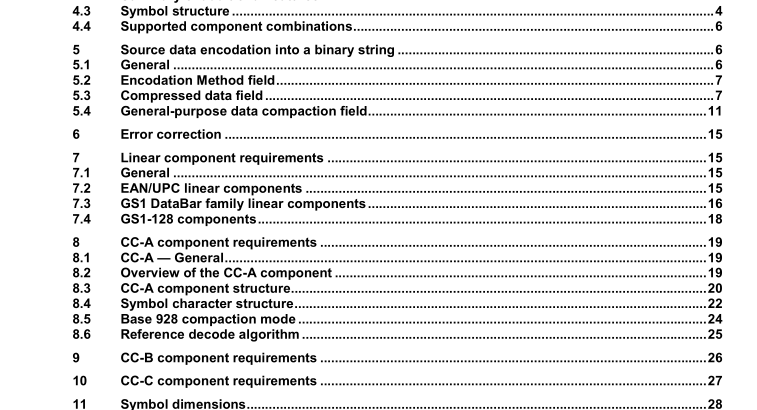ISO IEC 24723:2010 pdf download – Information technology — Automatic identification and data capture techniques — GS1 Composite bar code symbology specification
The date is encoded by stripping the two-digit AI 11 or AI 17 from the date element string and encoding the remaining six digits into 16 bits using the equation above. For AI 11, the next bit is “0”; for AI 17 the next bit is “1”.
If there was no date, a 2-bit field of “11” is encoded instead of the 17-bit field. If a lot number directly follows the date element string, the two-digit AI 10 is stripped from the lot number element string, and the remainder of the lot number element string is encoded using general-purpose data compaction, directly following the date field. If more AI element strings follow the lot number, a FNC1 separates the lot number data from the next AI element string to be encoded. If a lot number does not directly follow the date element string, a FNC1 is encoded following the date element string, even if no more data follows the date element string (this FNC1 shall not be transmitted by the decoder).
If more data follows, it is encoded using general-purpose data compaction beginning with the digits of the next AI. The decoder shall reconstruct the AI element strings from a compressed data field using an Encodation Method field of “10” according to the following procedure:
a) If the bits “11” follow the method “10”, no date is encoded, and the decoder shall insert the two-digit AI 10 before the remaining general-purpose data compaction field is decoded.
b) Otherwise, the 6-digit date shall be extracted according to the above equation. If the seventeenth bit is “0”, an AI 11 for production date is added as a prefix by the decoder. If the seventeenth bit is “1”, an AI 17 for expiration date is added. If the first encoded data character following the date field is FNC1, there is no lot number (this FNC1 shall not be transmitted by the decoder). Otherwise the decoder shall insert the two- digit AI 10 before the remaining general-purpose data compaction field is decoded.
5.3.2 Encodation Method field of “11” — AI 90 This Encodation Method may be used if an element string with an AI 90 occurs at the start of the data message, and if the data field following the two-digit AI 90 starts with an alphanumeric substring which complies with a specific format. The format of the alphanumeric data that can be used in this compaction method is 0, 1, 2, or 3 digits (strings with leading zeros do not comply with the required format) followed by an uppercase alphabetic character.
An Encodation Method field of “11” is followed by a compressed data field which includes the encoded special-format alphanumeric string, followed by the remainder of its data field, optionally additional compressed data fields, and optionally additional AI element strings. The compressed data field following the “11” Encodation Method consists of the following:
a) One or two bits indicating the starting data encodation scheme used for the remainder of the AI 90 data field. A “0” indicates Alphanumeric encodation, a “10” indicates Numeric encodation and an “11” indicates Alpha encodation (see 5.3.3).
b) One or two bits indicating the absence or presence, respectively, of specific AIs after the first FNC1 (which terminates the AI 90 element string, unless no further data is encoded). “0” indicates that either no more data is encoded, or that the remaining data is encoded according to general-purpose data compaction rules. Otherwise, the AI of the next element string will not be explicitly encoded. “10” indicates that an AI 21 follows, and “11” indicates that an AI 8004 follows.
c) Nine or 20 bits encoding the 1 to 4 characters of the alphanumeric string that followed the AI 90 in the source message, encoded as follows:
1) Convert the numeric portion of the alphanumeric string to a value. If the string contains no numeric digits, the value is 0.ISO IEC 24723 pdf download.
